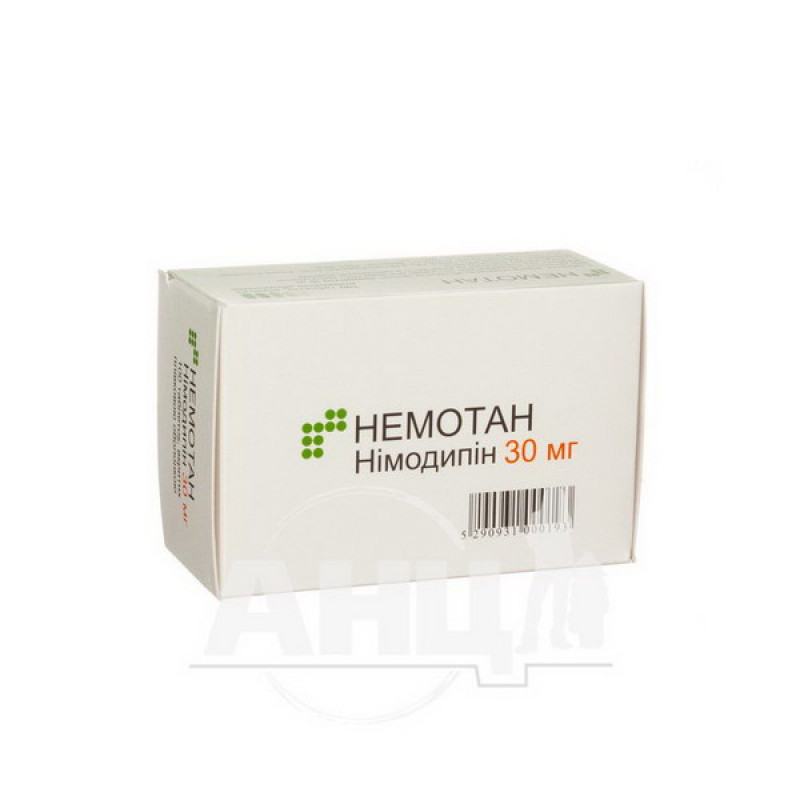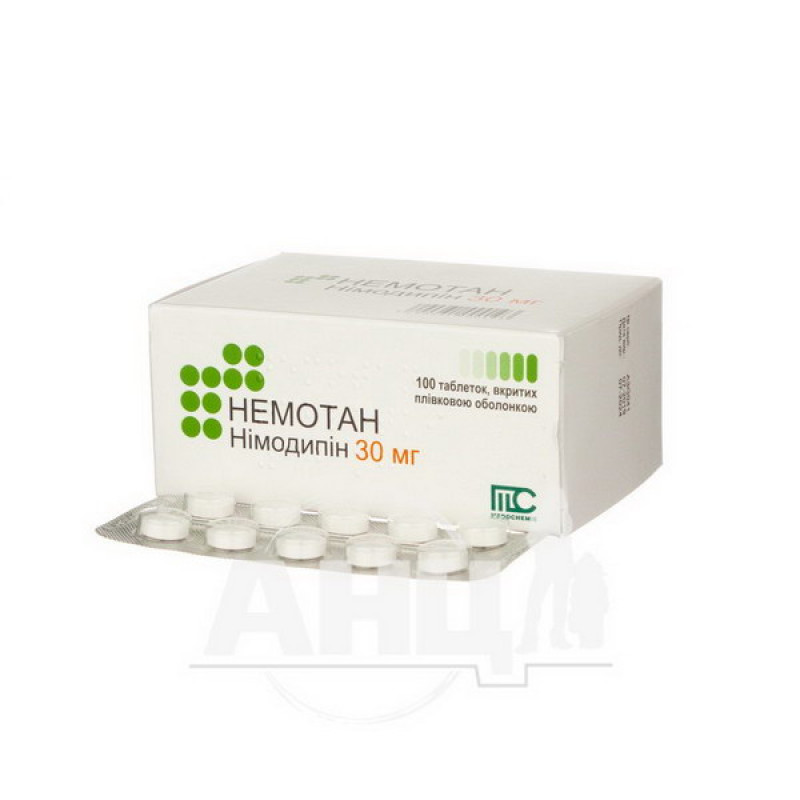Nemotan film-coated tablets 30 mg No. 100

Pharmacological properties
Pharmacodynamics. Nifedipine has a pronounced selective effect in some areas of the brain. Its therapeutic properties are associated with the ability to inhibit the contraction of smooth muscle cells caused by calcium ions.
Nimodipine protects neurons and stabilizes their function; it favorably affects cerebral blood flow and increases tolerance to ischemia by interacting with neuronal receptors and cerebrovascular receptors associated with calcium channels. Other studies have shown that it does not lead to an intracerebral hijacking phenomenon.
Nimodipine has been clinically demonstrated to reduce memory impairment and improve concentration in patients with impaired brain function.
Nimodipine has a positive effect on other typical symptoms, as evidenced by the assessment of general clinical indicators and individual disorders, as well as behavioral observations and psychometric tests.
Pharmacokinetics. Absorption. The active substance nimodipine is almost completely absorbed after oral administration. C max in blood plasma and AUC increase proportionally to the dose up to the highest dose tested (90 mg).
The estimated volume of distribution (Vss, dual-compartment model) for intravenous administration is 0.9-1.6 l/kg body weight. The total (total) clearance is 0.6-1.9 l/h/kg.
Protein binding and distribution. Blood protein binding reaches 97-99%.
Metabolism and elimination: Nimodipine is eliminated by metabolism via the cytochrome P450 3A4 system.
Bioavailability. Due to intensive presystemic metabolism (about 85-95%), absolute bioavailability is 5-15%.
Indication
Prevention and treatment of ischemic neurological disorders caused by cerebral vasospasm after subarachnoid hemorrhage due to aneurysm rupture.
Treatment of elderly patients with functional brain disorders with severe symptoms.
Application
Treatment of patients with functional brain disorders. In the treatment of elderly patients with functional brain disorders, the recommended dose (unless otherwise prescribed by the doctor) is 1 tablet of Nemotan 3 times a day (30 mg of nimodipine 3 times a day).
In patients with significantly reduced renal function (glomerular filtration rate less than 20 ml/min), the need for treatment should be carefully considered and the patient should be systematically examined.
Prevention and treatment of ischemic neurological disorders caused by spasm of cerebral vessels after subarachnoid hemorrhage due to rupture of an aneurysm. After a course of infusion therapy, Nemotan is prescribed orally at a dose of 60 mg (2 film-coated tablets) 6 times a day.
In case of adverse reactions, the dose should be reduced, and if necessary, the use of the drug should be discontinued.
Impaired liver function, especially in cirrhosis, may lead to increased bioavailability of nimodipine due to reduced completeness of first-pass metabolism and reduced metabolic clearance. Adverse reactions (e.g., decreased blood pressure) may be more pronounced. In such cases, the dose should be reduced and, if necessary, the drug should be discontinued.
When used simultaneously with CYP 3A4 inhibitors or inducers, dose adjustment may be required (see Interactions with other drugs).
Swallow the tablets whole, without chewing, with a small amount of liquid, regardless of meals, at intervals of at least 4 hours. It is not recommended to use grapefruit juice simultaneously with the drug.
Children. The drug is not used in children.
Contraindication
The use of the drug is contraindicated in individuals with individual hypersensitivity to nimodipine or other components of the drug. The use of nimodipine in combination with rifampicin is contraindicated, since the simultaneous use of these drugs leads to a significant decrease in the effectiveness of nimodipine.
Antiepileptic drugs (phenobarbital, phenytoin, carbamazepine) significantly reduce the bioavailability of nimodipine, therefore simultaneous use with these drugs is contraindicated.
Nimodipine should not be used in unstable angina and myocardial infarction and/or within 1 month of their occurrence.
Severe hepatic impairment, especially in cirrhosis, may lead to increased bioavailability of nimodipine due to reduced completeness of first-pass metabolism and reduced metabolic clearance. Therefore, nimodipine should not be used for the treatment of functional brain disorders in patients with severe hepatic impairment (e.g. cirrhosis).
Side effects
Below is a list of adverse drug reactions based on clinical trials of nimodipine for the indication "subarachnoid hemorrhage due to aneurysm".
From the blood and lymphatic system: changes in blood test parameters, thrombocytopenia.
On the part of the immune system: acute hypersensitivity reactions, allergic reaction, rash.
Nervous system: nonspecific cerebrovascular symptoms, headache.
Cardiac: nonspecific arrhythmias, tachycardia, bradycardia.
From the vascular system: nonspecific cardiovascular symptoms, hypotension, vasodilation.
Liver and biliary tract: mild to moderate liver reactions, transient increase in liver enzyme activity.
Below is a list of adverse drug reactions based on clinical studies of nimodipine for the indication "treatment of functional brain disorders".
On the part of the immune system: acute hypersensitivity reactions, allergic reaction, rash.
Nervous system: nonspecific cerebrovascular symptoms, headache, vertigo.
Nonspecific neurological symptoms: dizziness, hyperkinesia, tremor.
Cardiac: nonspecific arrhythmias, palpitations, tachycardia.
Vascular disorders: nonspecific cardiovascular symptoms, hypotension, vasodilation, syncope, edema.
Gastrointestinal: gastrointestinal disorders, constipation, diarrhea, flatulence.
Special instructions
Treatment for functional brain disorders. When treating the elderly, patients with severe renal dysfunction (glomerular filtration rate less than 20 ml/min) or severe cardiovascular pathology, the need for treatment should be carefully considered and the patient should be systematically examined.
Prevention and treatment of ischemic neurological disorders caused by cerebral vasospasm after subarachnoid hemorrhage due to aneurysmal rupture. Although the use of nimodipine is not associated with an increase in intracranial pressure, in these cases or when the water content in the brain tissues is increased (generalized cerebral edema), careful monitoring of the patient is recommended.
Treatment of functional brain disorders or prevention and treatment of ischemic neurological disorders caused by spasm of cerebral vessels after subarachnoid hemorrhage due to rupture of aneurysm. The use of nimodipine requires special caution in hypotension with a systolic blood pressure level below 100 mm Hg.
Nimodipine is metabolized via the cytochrome P450 3A4 system. Therefore, drugs that affect this enzyme system may alter the primary metabolism or clearance of nimodipine.
Drugs that are inhibitors or inducers of the cytochrome P450 3A4 system may lead to an increase in the concentration of nimodipine in the blood plasma: macrolides (e.g. erythromycin), anti-HIV protease inhibitors (e.g. ritonavir), azole antifungals (e.g. ketoconazole), antidepressants nefazodone and fluoxetine, quinupristin/dalfopristin, cimetidine, valproic acid.
When using these drugs simultaneously, it is necessary to monitor blood pressure and, if necessary, consider reducing the dose of nimodipine.
Use during pregnancy or breastfeeding
Pregnancy. Appropriate studies on the effects on pregnant women have not been conducted. If it is necessary to use the drug during pregnancy, the benefits and potential risks of taking the drug should be carefully weighed depending on the severity of the clinical picture.
Breastfeeding. It has been found that the concentration of nimodipine and its metabolites in breast milk is in the order of magnitude of that in maternal plasma. Mothers are not recommended to breastfeed their infants while taking the drug.
The ability to influence the reaction rate when driving a car or working with other mechanisms. The ability to drive a car and mechanisms may be impaired due to the possible occurrence of dizziness.
Interactions
Nimodipine is metabolized by the cytochrome p450 3a4 system, located both in the intestinal mucosa and in the liver. Therefore, drugs that affect this enzyme system may alter the primary metabolism or clearance of nimodipine.
When using nimodipine simultaneously with the following drugs, the degree as well as the duration of the interaction must be taken into account.
Based on experience with other calcium channel antagonists, it is known that rifampicin will enhance the metabolism of nimodipine due to enzyme induction. Thus, the simultaneous use of rifampicin and nimodipine leads to a significant decrease in the effectiveness of the latter. The use of Nemotan in combination with rifampicin is contraindicated.
Antiepileptic drugs (phenobarbital, phenytoin, carbamazepine) significantly reduce the bioavailability of nimodipine tablets, therefore the simultaneous use of Nemotan with these drugs is contraindicated.
When using the following inhibitors of the cytochrome P450 3A4 system simultaneously, blood pressure should be monitored and, if necessary, a dose adjustment of nimodipine should be considered.
No interaction studies have been conducted between nimodipine and macrolide antibiotics. Some macrolide antibiotics (e.g. erythromycin) are known to inhibit the cytochrome P450 3A4 system and the possibility of drug interactions at this stage cannot be excluded. However, macrolide antibiotics should not be used with nimodipine.
No formal studies have been conducted to investigate the potential interaction between nimodipine and anti-HIV protease inhibitors (e.g. ritonavir). Drugs of this class have been shown to be potent inhibitors of the cytochrome P450 3A4 system. Taking this into account, the possibility of a pronounced and clinically significant increase in nimodipine plasma concentrations when co-administered with protease inhibitors can be excluded.
No formal studies have been conducted to investigate the potential interaction between nimodipine and ketoconazole. Azole antifungals are known to inhibit the cytochrome P450 3A4 system and various interactions have been reported for other dihydropyridine calcium channel antagonists. Therefore, a significant increase in the systemic bioavailability of nimodipine due to a decrease in first-pass metabolism cannot be excluded when co-administered with nimodipine tablets.
No formal studies have been conducted to investigate the potential interaction between nimodipine and nefazodone. The antidepressant has been reported to be a potent inhibitor of cytochrome P450 3A4. However, the possibility of increased plasma concentrations of nimodipine when co-administered with nefazodone cannot be ruled out.
Long-term concomitant use of Nemotan and fluoxetine caused an increase in the concentration of nimodipine in the blood plasma by almost 50%. The effect of fluoxetine was significantly reduced, but the effect of its active metabolite norfluoxetine was not.
Based on experience with nifedipine, its simultaneous use with quinupristin/dalfopristin may lead to an increase in the concentration of nimodipine in the blood plasma.
Simultaneous use of the drug Nemotan and the H2 receptor antagonist cimetidine or valproic acid preparations may lead to an increase in the concentration of nimodipine in the blood plasma.
Long-term use of nimodipine with the antidepressant nortriptyline leads to a slight increase in the concentration of nimodipine in the blood plasma; the concentration of nortriptyline remains unchanged.
Nimodipine may enhance the hypotensive effect of the following antihypertensive drugs when used simultaneously: diuretics, β-adrenergic blockers, ACE inhibitors, α 1 -antagonists, other calcium antagonists, α-adrenergic blocking agents, phosphodiesterase-5 inhibitors, α-methyldopa.
However, if combinations of this type cannot be avoided, special monitoring of the patient's condition is required.
In a study in monkeys, it was found that simultaneous intravenous administration of nimodipine and the drug for the treatment of HIV patients zidovudine leads to a significant increase in the AUC of zidovudine and a decrease in its volume of distribution and clearance.
Grapefruit juice inhibits the cytochrome P450 3A4 system. The use of dihydropyridines - calcium channel antagonists - simultaneously with grapefruit juice leads to an increase in plasma concentration and prolonged action of nimodipine due to reduced first-pass metabolism or clearance. As a result, the hypotensive effect of the drug may increase. After the use of grapefruit juice, this effect may last for at least 4 days, therefore the simultaneous use of grapefruit / grapefruit juice and nimodipine is not recommended.
Overdose
Symptoms: in acute overdose, pronounced hypotension, tachycardia or bradycardia, nausea, and gastrointestinal disorders are noted.
Treatment: in case of acute overdose, immediate withdrawal of the drug is recommended. In case of emergency, symptomatic therapy is indicated. As emergency therapy, gastric lavage is recommended, followed by the use of activated charcoal.
With further decrease in blood pressure, intravenous norepinephrine or dopamine should be administered. Since the specific antidote is unknown, in case of other adverse reactions, symptomatic therapy is indicated.
Storage conditions
At a temperature not exceeding 25 °C in the original packaging.
There are no reviews for this product.
There are no reviews for this product, be the first to leave your review.
No questions about this product, be the first and ask your question.






